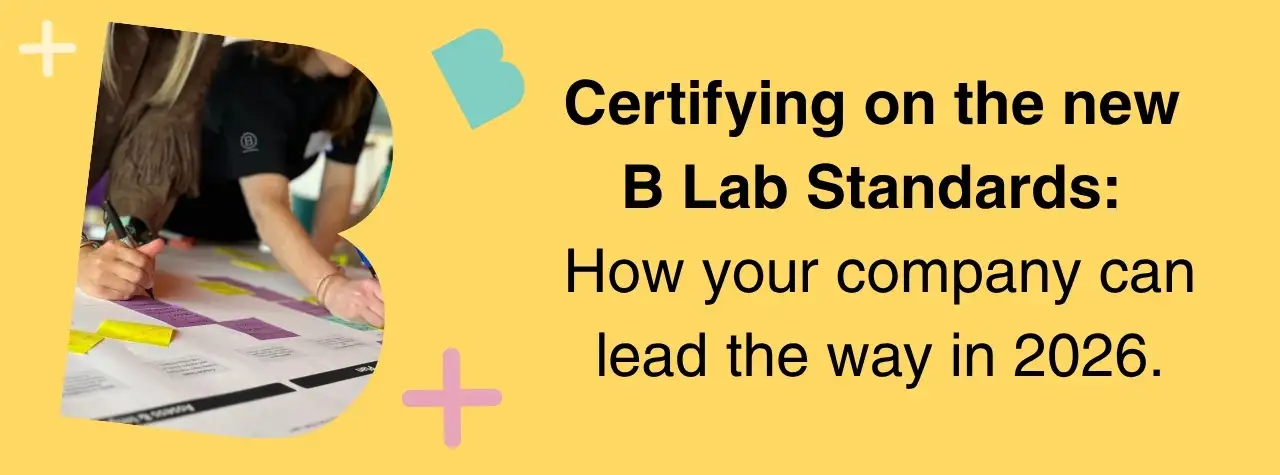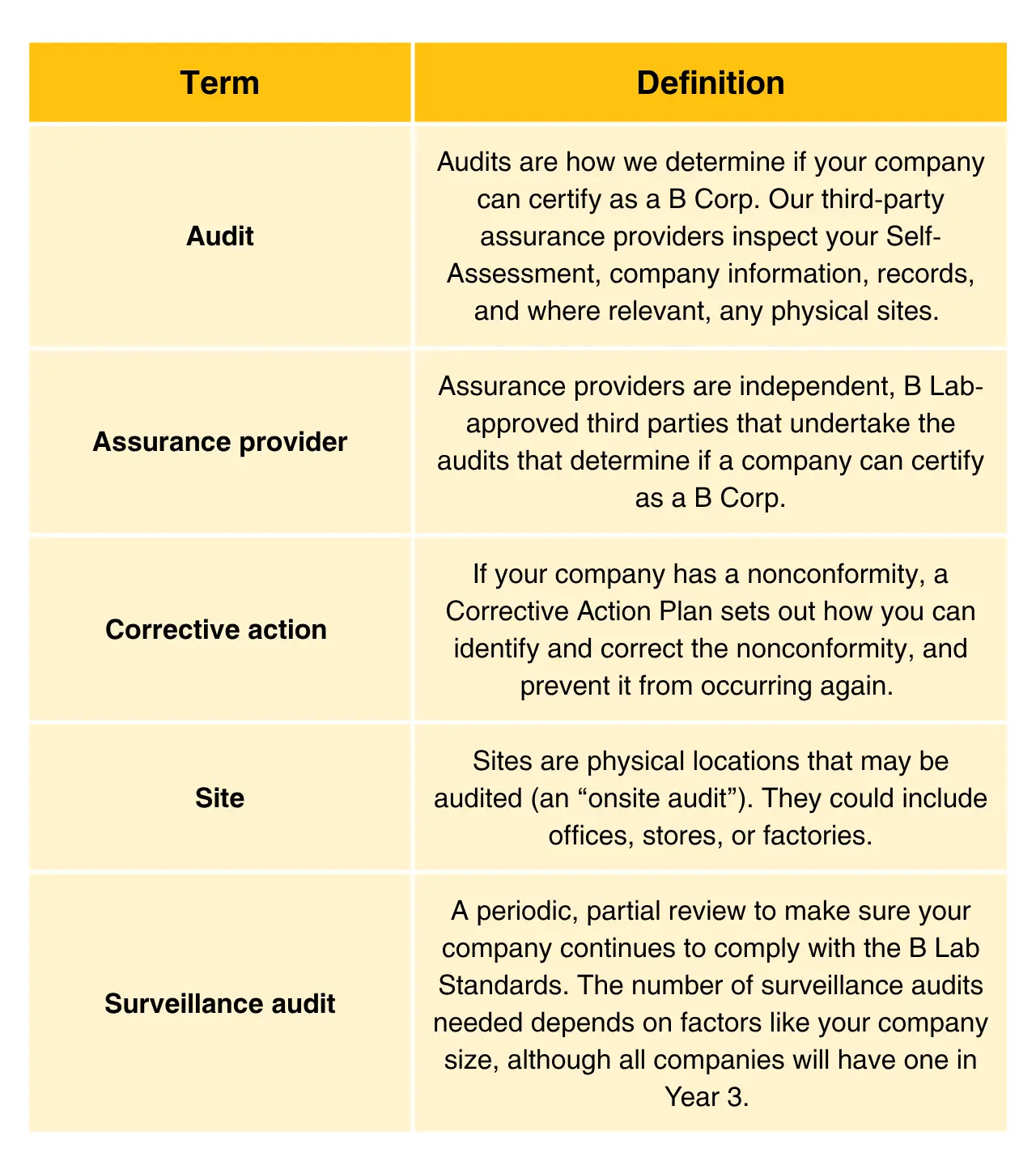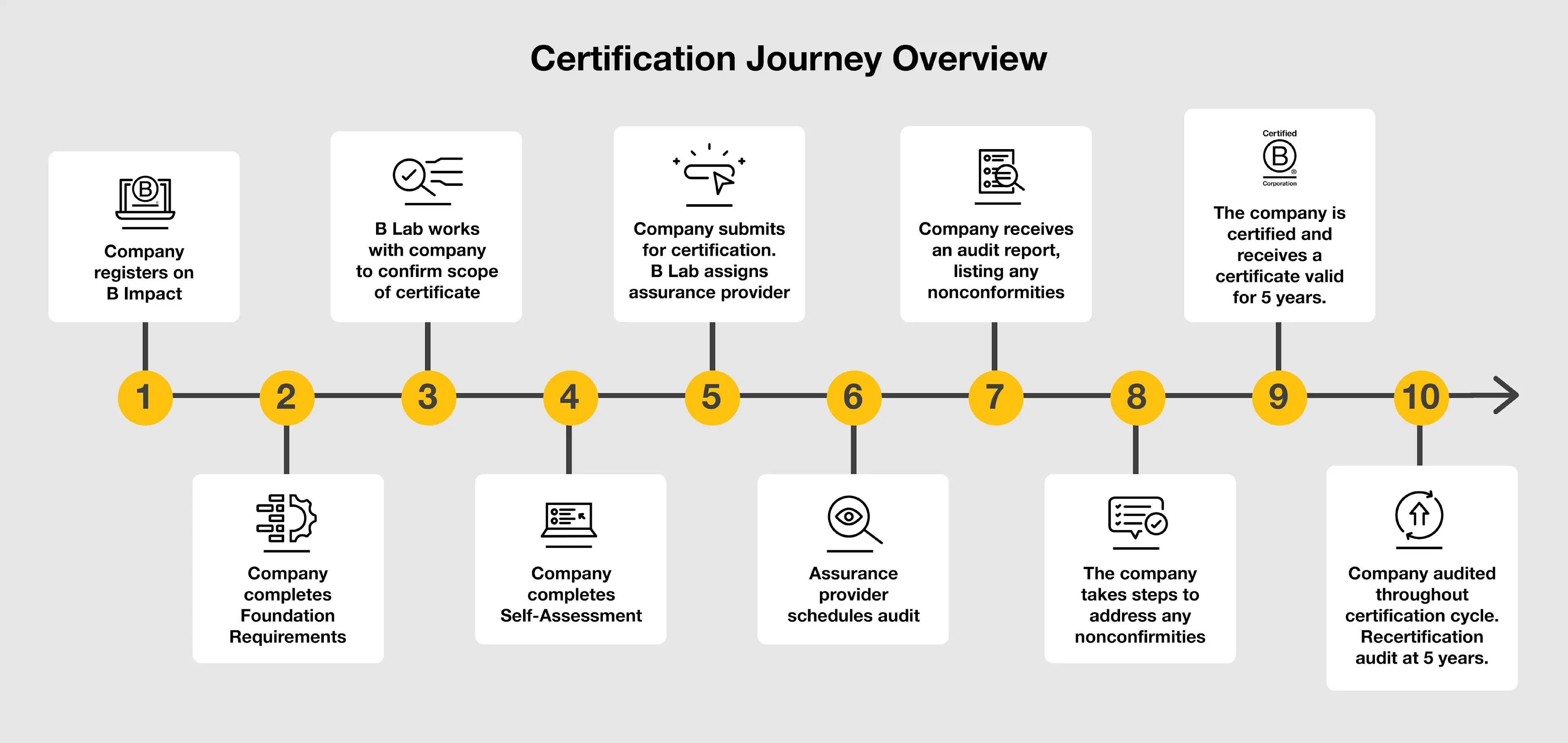Certifying on the New B Lab Standards: How Your Company Can Lead the Way in 2026

The B Corp movement has always been about more than just business as usual—it's about demonstrating that a better way is possible. In January 2026, B Lab will begin recertifying existing B Corps on the B Lab Standards V2.1, and in March, new B Corps will be able to certify. Whether you’re already a B Corp or have ambitions to become one, this is your moment to help pioneer a new chapter.
The shift to the new B Lab Standards, coupled with a transition to third-party certification, is not just about adapting—it's about leading. Our society needs a community of businesses that are not only willing, but eager to raise the bar on social and environmental performance, and that can drive the change needed to address the biggest challenges we face—working towards a shared goal of a more equitable, regenerative economy.
From climate action to environmental conservation, employee wellbeing to considering stakeholders in decision-making, the new B Lab Standards offer a blueprint for all businesses seeking to drive positive change and accountability. With new standards come new certification processes—and new opportunities. We’re supporting B Corps to communicate their impact and sustainability efforts through certification, safeguarding their reputation and credibility while reducing financial and legal risk. Here’s how:
Credible, third-party certification. The B Corp logo signals that you uphold social, environmental, and governance standards laid out by B Lab. Companies on the B Lab Standards V2.1 will be certified by an independent, B Lab-approved third party assurance provider meeting requirements based on ISO 17021-1.
Make substantiated claims and reduce the risk of greenwashing. In January 2026, B Lab will share new brand resources including an extensive, pre-approved messaging library backed by proof points, tested with consumers, reviewed by B Lab experts, and rooted in our standards. This will ensure your messaging is both authentic and substantiated, simplifying the work for you. Many of this new brand messaging can only be used by companies certified on V2.1.
Simplifying the path to ECGT compliance. The new certification model under B Lab Standards V2.1 provides companies of all sizes with a streamlined way to comply with the European Union Directive on Empowering Consumers for the Green Transition (ECGT), and meets the legal requirements for being a valid sustainability label in the European Union (EU).
A step to avoid fines and brand damage. The B Lab Standards V2.1, and our approved B Corp messaging and brand guidelines, are developed to comply with ECGT, reducing your company’s financial risk and the significant brand damage that comes from noncompliance.
Position your business as a purpose-driven leader. This is the moment for your company to be a pioneer in a new era of social and governance standards. Become an early adopter, and help lead the way as we raise the bar for business impact.
For any company marketing products or services to consumers in the EU, a credible, third-party certification is no longer just a good choice—it is a legal requirement for using a sustainability label. B Lab will be prioritizing the recertification of companies that are impacted by the ECGT Directive. If your company is communicating with consumers in the EU, and therefore impacted by ECGT, you should self-identify as ECGT-impacted in the B Impact platform. For further information, or if you’re unsure if your company is impacted by the ECGT directive, please read the ECGT article and updated FAQs.
Self-identify as an ECGT-impacted B Corp on B Impact. This will help B Lab direct specific information and support to you during your recertification journey.
Continue completing the Self-Assessment. This will help you understand what work you may need to do within your business to be ready for recertification.
Look out for detailed certification guidance in early November. We’ll be sharing full details of the certification process so that you can be prepared to be recertified by September 2026.
As we begin to certify companies on the B Lab Standards V2.1, we’re introducing a streamlined and rigorous auditing process based on internationally accepted norms. We’re extending the certification cycle to five years, meaning that companies will be expected to advance their actions over a five-year period—initially meeting the Year 0 requirements, then gradually complying with Year 3 and Year 5 requirements.
We are also adding more regular monitoring of compliance during the five years, known as “surveillance audits”, aligning with the continuous improvement ambitions of the standard. We’re in the process of developing Certification Requirements Guides that will first be used to prepare our assurance providers, before being shared with B Corps in November 2025 to further support your company in navigating this journey.
We appreciate your patience while we navigate this new process, and we’ll be sharing more information as soon as we can. For now, you can familiarize yourself with the high-level overview of the certification process, and some new terms.
Glossary of New Terms


Step 1: Company registration. To start the B Corp certification process, a company must register itself in B Impact and complete the Assessment Setup.
Step 2: Foundation Requirements review. The company assesses themselves against the required B Lab Standards Foundation Requirements. B Lab confirms that the company is eligible for certification.
Step 3: Scoping. The company and B Lab confirms the scope of the certification, including which entities are included and which brands will carry the B Corp logo.
Step 4: Self-Assessment. The company completes the Self-Assessment against the B Lab Standards V2.1 in B Impact.
Step 5: Submission and assurance provider selection. The company submits for certification and B Lab assigns an assurance provider to the company.
Step 6: Audit. The assurance provider schedules and conducts an audit with the company. The audit will be time-bound and may be conducted onsite or remotely.
Step 7: Audit report. The company receives an audit report, listing any nonconformities the company needs to address to meet B Lab Standards V2.1. Step 8: Corrective actions. The company takes steps to address any nonconfirmities that were identified during the audit. Major nonconformities must be addressed before the company can be certified, while minor nonconformities can be addressed before the next audit (see below for how we define nonconformities).
Step 9: Issuing the certificate. The company is certified and receives a certificate valid for 5 years.
Step 10: Surveillance and recertification audits. The company is audited throughout the certification cycle with the frequency being determined based on the size and sector of the company.
B Lab estimates that from submission to certification, the full certification process will take 2-6 months mainly depending on the number of major nonconformities. Once a company submits for certification, an audit will be scheduled. The audit itself will be a time-bound activity, taking between 1 day and 10 days, depending on the size of the company. Following the audit, the biggest impact on length of time to reach certification will be down to the number of major nonconformities that need to be resolved before the company is able to be certified. If a company has no major nonconformities, the process will be relatively quick, and smaller companies could be certified within 2 months from submission.
In order to remain certified, ongoing surveillance audits and a special one-off audit in Year 3 are required, covering both Year 0 and Year 3 requirements. However, not all companies will have the same audit schedule within their five-year cycle: The frequency and type of audits that occur across the five-year period depend on the company’s specific circumstances (for example, their sector and size). Not every company site will be audited. Micro and small companies will only be audited at Year 0, Year 3, and Year 5, whereas larger companies are likely to be audited annually.
Sometimes, a company fails to meet an applicable requirement of the B Lab Standards. This is known as a "nonconformity", and can be categorized as either minor or major.
A minor nonconformity is a single, observed lapse. For an initial audit, the company must provide a root cause analysis and submit a corrective action plan. These must be resolved by the next audit. If a minor non-conformity is not addressed, it is elevated to a major nonconformity.
Example of minor nonconformity: Some employees were found to not receive a living wage due to the timing of their hiring, and it was determined to be an oversight.
A major nonconformity is a more material finding, such as a systemic failure to meet a requirement.
Example of major nonconformity: The company is found to not have a fair wage methodology in place for any staff under the Fair Work Impact Topic.
Let’s embrace this next step, together
We’re busy preparing all of our systems and processes to guide you through the new certification process. Our partnerships with assurance providers are being finalized, our technology prepared for launch, and we’re training our employees and auditors to be ready to guide you when certification begins.
We’re excited to get started in the new year, and to support you in this next phase of our journey together. But we also want to acknowledge the volume of change taking place, and the work we’re asking of you, our community, to stay a part of the B Corp movement.
This coming period of change won’t be without its challenges, but we are evolving because we recognize how vital this change is. Our world is at a crossroads, and we believe that business has the opportunity—and responsibility—to lead where governments fall short. We know the impact our community’s collective power can have in shifting structural and cultural norms. We ask a great deal of you, because we know the pioneering spirit and capacity for leadership B Corps have—and what we can achieve when we raise the bar for all businesses.
We’re in this together.